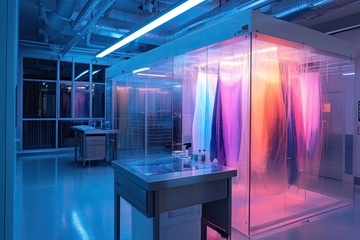Join us on Nov 6, 2025 at 8:00pm (20:00) ET
Available until: Nov 30, 2026
Protecting workers from airborne and hazardous contaminants extends far beyond relying solely on Personal Protective Equipment (PPE). While PPE remains a valuable safeguard, proper long-term safety depends on integrating more effective engineering controls. This webinar will explore how operator enclosures (microenvironments) can serve as highly effective barriers, minimizing exposure risks and creating healthier workspaces.
What Are Operator Enclosures?
Operator enclosures are sealed and ventilated structures designed to physically isolate workers from substances that could pose a threat to their health. By separating workers from direct sources of contaminants, enclosures provide a higher and more reliable level of protection compared to PPE alone.
Key Benefits You’ll Learn About:
-
Reduced Exposure: Enclosures dramatically reduce worker contact with hazardous contaminants, thereby lowering the dependency on PPE and providing a stronger line of defense.
-
Improved Air Quality: With integrated clean air systems—such as HEPA filtration or pressurization—operator enclosures maintain a controlled and contaminant-free environment inside.
Join us to understand the importance of shifting workplace safety strategies toward controls that provide sustainable, long-term protection. You’ll gain an understanding of how engineering innovations like operator enclosures can benefit both worker health and organizational compliance.
Objectives
Upon completion, participants will be able to:
- Define the different types of microenvironments
- Identify the main problems observed in the non-controlled operating enclosure
- List testing methods and key performance indicators for proper follow-up with micro-environments
Lecturer
Dylan Thomas McLaughlin, M.Sc., M.Sc.A, CIH, ROH
Dylan Thomas McLaughlin is a Certified Industrial Hygienist (CIH) and Registered Occupational Hygienist (ROH) with a strong academic foundation in physical chemistry and more than eight years of hands-on experience in industrial hygiene. Much of his career was spent in the aluminum smelting industry, where he gained specialized expertise in managing chemical and physical hazards, with a particular focus on heat stress and noise exposure. Recently, Mr. McLaughlin moved into consulting, based in Montreal, Québec, where he now supports a diverse range of clients—from industrial facilities to pharmaceutical organizations—in addressing complex occupational health challenges, especially those related to hazardous contaminants. Known for his practical insights and technical depth, Dylan brings a unique perspective to workplace safety and engineering controls. Outside of his professional role, he enjoys board games and cherishing time with his wife and three children.
Credit
This course contains 1 hours of instruction. 0.1 CEUs are offered for this course.
As an IACET Accredited Provider, Bowen Learning Network offers CEUs for its programs that qualify under the ANSI/IACET Standard.
Eligible for contact hours with the BGC, BCSP, IHMM, and other OEHS certifying agencies.
For more details on certification and recertification credit, please visit How many points/credits/hours is a course worth?
Completion Requirements
To receive a Certificate of Completion for this course, participants are required to complete the following items:
- Participate in the live webinar or review the on-demand webinar recording.
- Score 70% or higher on the quiz.
- Complete the webinar evaluation.
No certificate will be awarded to participants who do not meet the above completion requirements.
Computer Requirements
The Bowen Learning Network online virtual classrooms are powered by BigBlueButton. It fully supports the Windows, Mac OS X, and Chromebook platforms (see below for versions supported). Support is available for iOS (iPads) and Android Tablets. While smart phones can be used, the screens are too small to display all of the aspects of the Virtual Classroom. For the best online learning experience, the use of a device with a larger screen is HIGHLY recommended. A physical keyboard is also recommended.
The Bowen EHS® Continuing Ed Package
Get access to all PDCs and Webinars in the package for one year and earn up to 50 contact hours.
See how the Virtual Classroom works:


